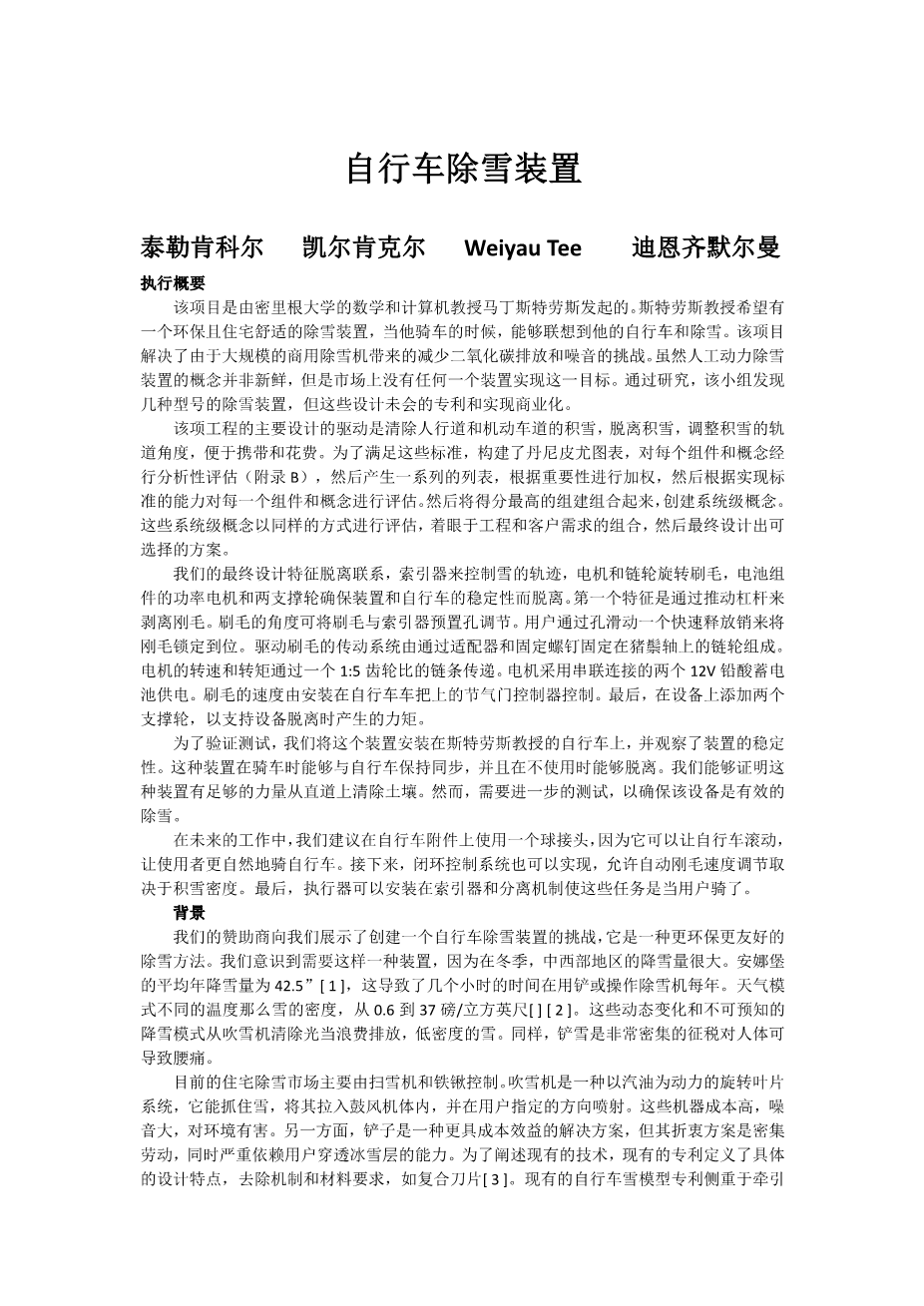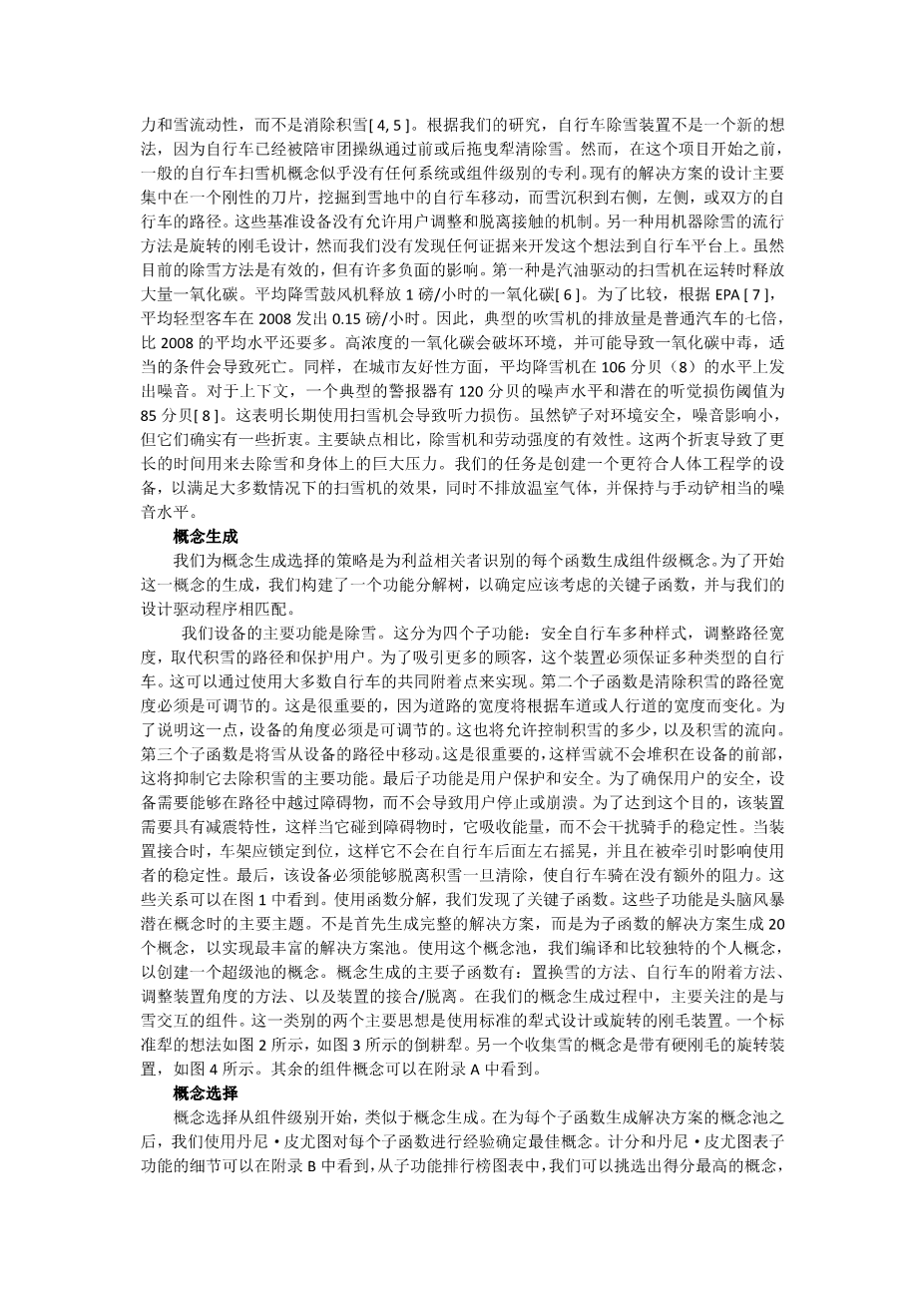Bicycle Snow Removal Device
Tyler Kaldobsky Kyle Kenkel Weiyau Tee Deane Zimmerman
Executive Summary
This project was motivated by Professor Martin Strauss, a University of Michigan Math and Computer Science professor. Professor Strauss desired an environmental and residential friendly snow removal device that can be easily attached to his bicycle and clear snow as he rides. The project addresses the challenge of reducing carbon emissions and noise produced by large scale commercial snow blowers. While the concept of a human powered snow removal device is not new, there are no devices available on the market that achieve this goal. Through research, the team found several models of human powered snow removal devices but none of these designs have been patented or commercialized.
The main design drivers of the project were to remove snow from the sidewalk and driveway, disengage, adjust the trajectory angle of snow, easy to attach and cost. To satisfy these criteria, Pugh charts were constructed to analytically assess each component and concept generated (Appendix B). A list of criteria was then generated and weighted according to the importance and each component and concept was subsequently rated based on the ability to fulfill the criterion. The highest scoring components were then combined to create system level concepts. These system level concepts were then evaluated in a similar manner, looking at a combination of engineering and customer requirements, allowing for a final design to be chosen.
Our final design features a disengagement linkage, an indexer to control snow trajectory, a motor and sprocket to spin the bristles, a battery assembly to power the motor and two support wheels to ensure stability of the device and bicycle while disengaged. The first feature is the ability to disengage the bristle by pushing a lever. The angle of the bristles can be adjusted by aligning the bristles with preset holes on the indexer. The user slides a quick release pin through the hole to lock the bristle in place. The transmission system that drives the bristles consist of a sprocket fastened to the bristle axle via an adaptor and a set screw. The rotation and torque of the motor is transmitted via a chain with a 1:5 gear ratio. The motor is powered by two 12V lead acid batteries connected in series. The speed of the bristles are controlled by a throttle controller that is mounted to the handlebar of the bicycle. Lastly, two support wheels are added to the device to support the moment produced when the device is disengaged.
For validation testing, we mounted the device onto Professor Strauss’ bicycle and observed the stability with the device on and off. The device was able to stay in-line with the bicycle when he was cycling and was able to be disengaged when not in use. We were able to validate that the device has enough force to clear soil from a straight path. However, further testing will be required for to ensure that the device is efficient in removing snow.
For future work, we propose that a ball joint be used at the bicycle attachment because it will allow the bicycle to roll and the user to ride in a more natural manner. Next, a closed loop control system can also be implemented to allow for automatic bristle speed regulation depending on snow density. Lastly, actuators can be installed in place of the indexer and disengage mechanism to enable these task to be done while the user is riding.
4
BACKGROUND
Our sponsor has presented us with the challenge of creating a bicycle snow removal device as a greener and more residential friendly alternative for removing snow. We realize the need for such a device because of the heavy snowfall in the Midwest during the winter months. The average annual snowfall in Ann Arbor is 42.5” [1], which leads to hours upon hours spent shoveling or operating a snow blower every year. As weather patterns differ in temperature so does the density of snow, varying from 0.6 to 37 [lbs/ft3] [2].These dynamically changing and unpredictable snowfall patterns result in wasteful emissions from snow blowers when removing light, low density snow. Similarly, shoveling dense snow is very taxing on the human body and can lead to back pain.
The current market for residential snow removal is dominated by snow blowers and shovels. A snow blower is a gasoline powered rotating blade system that grabs snow, pulls it into the blower body and shoots it in the user specified direction. These machines are costly, loud and harmful to the environment. Shovels, on the other hand, are a more cost effective solution, but the tradeoff is the intensive labor along with relying heavily on the user’s ability to penetrate the layers of snow and ice. To elaborate on the existing technology, patents that exist define specific design characteristics of removal mechanisms and material claims, such as a composite blade [3]. Existing patents for bicycle snow models focus on traction and snow mobility as opposed to removing snow [4, 5]. Based on our research, the bicycle snow removal device is not a new idea because bicycles have been jury rigged to remove snow via a front or a rear towed plow. Before the start of this project, however, there does not seem to be any system or component level patents for the general bicycle snow plow concept. The design of the existing solutions is primarily focused on a rigid blade(s) digging into the snow as the bicycle moves, while depositing the snow to the right, left, or both sides of the bicycle’s path. These benchmark devices do not have a mechanism that allows for user adjustability and disengagement. Another popular method of removing snow by machine is a rotating bristle design, however we have found no evidence of any prototype that has been developed to apply this idea to a bicycle platform. W
剩余内容已隐藏,支付完成后下载完整资料


英语译文共 6 页,剩余内容已隐藏,支付完成后下载完整资料
资料编号:[477842],资料为PDF文档或Word文档,PDF文档可免费转换为Word
以上是毕业论文外文翻译,课题毕业论文、任务书、文献综述、开题报告、程序设计、图纸设计等资料可联系客服协助查找。


